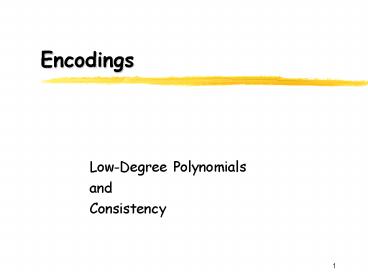Encodings - PowerPoint PPT Presentation
Title: Encodings
1
Encodings
- Low-Degree Polynomials
- and
- Consistency
2
Strings Functions
- One can describe an n-bit string s ? ?ns s1,
s2, , sn - as a function from an index to the letter
appearing on the indexs entry of the string - s 1..n a ?
- On the other hand, a function D a Rcan be
thought of as a string ? RD spelling s
value on each point of D
3
Error Correcting Codes
- An encoding E maps strings of length n to strings
of length m (gtgt n) - E ?n ?m
- It is an ?-code if for any s1 ¹ s2 ? ?n D(
Es1, Es2 ) ³ 1 - ? - (where D( x, y ) denotes the fraction of entries
x and y differ on)
4
A Generic ?-code
- Set ? to be the finite field Zp (for prime p) and
assume, for simplicity, that ? ? and m p - Given s ? ?n , let Es be the (string-ization of
the) function ? ? that satisfies is the
(unique) degree n-1 polynomial so that (t)
st for all 1 t n - Es can be interpolated from any n points (being
a univariate polynomial of degree n-1) hence,
Es1 Es2 may agree on at most n-1 points - Therefore, E is an n-1 / ?-code
5
Polynomials over Finite-Fields
- Let now ? ? d be a geometric-space
- (this is to say that no complex properties of ?
would be used, only simple, geometric ones) - denote by d the dimension of ?.
- Consider now a polynomial
- ? a ?
- of degree h in each variable
- hd is s total degree (or simply degree).
6
Useful Properties of Low-Degree Polynomials
- Interpolation the value of on any point of ?
can be interpolated from many (almost all) sets
of (h1)d points of ?. - In fact, s value is some linear combination
of the values of on those (h1)d points - If, however, ? a ? is not of degree d(h1),
interpolation of a single point p ? ? from
different sets of (h1)d points may give
different valuesnamely be inconsistent
7
More Useful Properties of Low-Degree Polynomials
- ?-codeTwo distinct polynomials, 1 and 2, can
agree on at most a very small (?) fraction of ?,
i.e. - D( 1 , 2 ) ³ 1 - ?
- Figure out what ? is.
- That is, what is the largest fractionof points
in ? two distinctdegree-r polynomials may agree
on - (Enough to analyze the case were is of degree
r in each variable)
8
Geometrical Properties of Low-Degree Polynomials
- Show the restriction of a degree-r polynomial,
to any dimension-d affine-subspace (i.e., cube
space shifted by an arbitrary vector), is a
dimension-d degree-r polynomial - Show the restriction of a degree-r polynomial to
a curve ? ? a ? of degree k ( ?(t) )is a
univariate polynomial of degree rk
9
Def Low-Degree-Extension (LDE)
- Let us now extend the generic encoding above of
univariate polynomials to higher dimension - Assume H ? ? ( Hltlt? ) and d logHn (thus n
? Hd) and an isomorphism Hd ? 1..n say by
writing each index in baseH A string s is
describable as a d-ary function s Hd a ? - Def LDE(s) ?d a ? such that
- extension LDE(s) agrees with s on Hd
- low-degree LDE(s) is of degree H-1 in each
variable (i.e., of degree (H-1)d )
10
- Write down the low-degree-extension of a string s
-- LDE(s) -- as an explicit function of its
entries s1, .., sn
11
Consistent Reading
- We need to be able to read a value of an LDE in a
globally consistent manner - That is, have a representation scheme (a set of
variables) for LDEs, and a reading procedure,
that for any arbitrary point p??, accesses a very
small number of representation variables and - rejects if inconsistency detected
- otherwise, returns w.h.p. a value for LDEs(p),
consistent among all points p
12
Consistency
- Simplistic procedure interpolate value from a
random set of hd points - This, however, requires hd accesses, while we
would need a consistent-reader that accesses only
a very small ( preferably poly-log(n), ultimately
constant) number of variables, and be guaranteed
global consistency
13
Consistency Test for Low-degree Polynomials
- A consistency test requires only that value for a
random p?? (not an arbitrary one) corresponds to
a global degree-r polynomial - Fix a Representation a set of variables
- A test is a family of Boolean-functions over
representation variables,each depending on a
small set of variables - hence referred to as
local-test - which may - reject if detects an inconsistency
- accept w.h.p. values conform to global
consistency
14
Global Consistency
- Pure global consistency would be for all entries
to be assigned values consistent with a single
low-degree polynomial - Accessing only a small number of variables,
however, small deviations (say changing one
value) can be detected only with very small
probability - Part of the definition of a test would be a
weaker notion of global consistency
15
Corresponding Game
- Prover sets values to all variables in the
representation - Verifier picks randomly a single local-test and
accepts or rejects according to its outcome - The error-probability of a test, is the fraction
of local-tests that can be made True despite the
assigned values not conforming to global
consistency. - I.e. the probability the verifier erroneously
accepts































